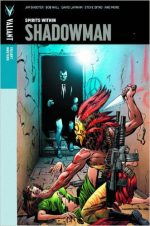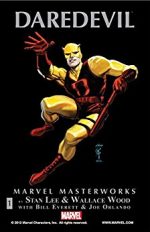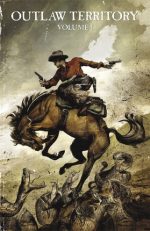
By Jim Shooter, Steve Englehart, Bob Hall, Faye Perozich, Seaborn Adamson, Steve Ditko, David Lapham, Don Perlin, Mark Moretti, Jose Delbo & various (Valiant)
ISBN: 978-1-939346-01-8
The 1990s were a slow period in terms of comics creativity: the industry had become infested with collector/investors and was increasingly market-led, with spin-offs, fad-chasing, shiny gimmicks and multiple-covers events replacing imagination and good story-telling in far too many places.
One notable exception was a little outfit with some big names that clearly prized the merits of well-told stories illustrated by artists immune to the latest mis-proportioned, scratchy poseur styles, but one with enough business sense to play the industry at its own game.
Eschewing most of the more crass profiteering stunts Valiant Comics revived some old characters and proved once more that the basics never go out of fashion. As Editor-in-Chief, Jim Shooter had made Marvel the most profitable and high-profile they had ever been, and after his departure he used that writing skill and business acumen to transform some almost forgotten Silver-Age characters into contemporary gold.
Western Publishing had been a major player since comics’ earliest days, blending a huge tranche of licensed titles with a few home-grown heroes like Brain Boy, Turok, Son of Stone and M.A.R.S. Patrol Total War (created by Wally Wood). The company’s most notable stars were Dr. Solar, Man of the Atom and Russ Manning’s magnificent science fiction cautionary tale Magnus, Robot Fighter. When the parent company closed its original comic division in 1984 these masterful sagas vanished but never faded from comic fans’ collective memory.
As the 1990s opened – and with a licensed agreement to resurrect some, any or all of these four-colour veterans – Shooter and co-conspirator Bob Layton came to a bold decision and made those earlier adventures part-and-parcel of their refit: acutely aware that old fans don’t like having their childhood favourites bastardized, and that revivals need all the support they can get.
Thus the old days were canonical: they “happened†and the new company was off and running with an intrigued and interested older fan-base already in place. Hit after hit followed and the pantheon of heroes expanded until dire market conditions and corporate chicanery ended the company’s stellar expansion just before the century closed.
Valiant fractionated and disappeared. It and its string of captivating creations have come and gone many times since then. The characters are currently divided between numerous publishers…
A new Valiant emerged in 2012 and, as well as offering all new adventures of many of its venerable stable of stars, the company have been systematically republishing the original back-catalogue in a series of Valiant Masters trade paperback/eBook collections.
During the heyday of the early ’90s Shooter and his team of upstarts were not content to simply revive and retrofit past glories. Once the older properties were firmly established, a legion of new characters was gradually added to the pantheon. One such was a voodoo-tainted, New Orleans-based wild man/daredevil named Jack Boniface…
Here – following an informative Foreword from writer/artist Bob Hall – the sagas from Shadowman #1-7 (May-November 1992) are re-presented; preceded by the crucial contents of Shadowman #0 which were initially revealed in April 1994.
In ‘Shadowmen’ Bob Hall & inker Tom Ryder recap the origins of Boniface before plunging back in time to 1875 where necromancer Anton Quigley shared too much of his arcane knowledge with his disciple Darque…
When Quigley later clashed with New Orleans gambler Maxim St. James, the mere mortal was murdered but revived by voodoo priestess Anjenetta who merged him with the power of the Loa as a Shadowman. Back from the grave and permanently furious, Maxim pursued his vengeance against Quigley even as the sorcerer demanded Darque surrender his adored sister Sandria to the demand of his master’s magic…
In the violent clash that followed, Quigley was destroyed whilst Darque ascended to a position of unassailable dominance, despite every effort of Nettie and Maxim to stop him. Over the intervening decades, Maxim was lost and the war stalled until the voodoo woman decided it was time to call forth another Shadowman…
After a truly seminal cameo in X-O Manowar #4 (not included here), musician Jack Boniface was properly introduced in 1992 in his own title. Shadowman premiered with ‘Jazz’, written by Shooter and Steve Englehart, illustrated by David Lapham and Joe Rubinstein.
The credits are a lot more complex that they might appear. Shooter famously used a communal brainstorming system to create characters and stories. The full credits for this collection read Plotters: Englehart, Shooter, Steve Ditko, David Lapham, Mark Moretti & Don Perlin; Writers: Englehart, Bob Hall, Faye Perozich, Shooter; Pencillers: Ditko, Lapham, Moretti and Inkers Charles Barnett III, Gonzalo Mayo, Rubinstein & Tom Ryder – and don’t get me started on the platoon of colourists, letterers and production people…
Boniface was a struggling session saxophonist trying to strike it rich in the Big Easy when he was seduced by Lydia, a mysterious woman he picked up in a club. Her sinister, trysting assault left him unconscious, amnesiac and forever altered by a bite to his neck. Unknown to Jack, she was an agent of the Spider Aliens who formed a covert keystone of the Valiant Universe, preying on humanity for millennia and indirectly responsible for creating many of the paranormal humans who secretly inhabit the world.
Alone in the morning light, Boniface discovered Lydia’s home was filled with half-digested corpses. Clearly he was intended as her next meal – but now has no idea how he survived or where she went. He cannot conceive of how much her bite has altered him…
Jack flees but later, as darkness falls, he feels agitated, restless, aggressive…
Roaming the streets he finds himself drawn back to Lydia’s home and stumbles upon a voodoo sacrifice. Attacked by the officiating priest the once-docile musician dons a Mardi Gras mask found at his feet and fights back with brutal abandon. Lydia has somehow turned him into a violent driven maniac, hungry for conflict – but only when the sun goes down…
In ‘Spirits Within’ (Perozich, Shooter, Lapham & Ryder) Jack’s own hunger for answers takes him to experts in both medicine and Obeah magic before his Shadowman self drags him into a confrontation with a Bayou axe murderer, whilst ‘The Beast and the Children’ (Perozich, Moretti & Barnett III) finds the increasingly off the rails music-man tackling mobsters and hit-men before destroying a well-connected super-powered child abuser.
With his heroic credentials fully established, issue #4 plunged Jack into the company’s first mega-crossover event. Unity gathered all Valiant’s disparate heroes – and many villains – in a timeless dimension where dinosaurs and cavemen existed side by side, fighting an endless war against quantum powered threat Mothergod until the trapped warriors could all get back to their times and places…
‘Sunburn’ by Lapham, Shooter, Perozich, Ryder & Maria Beccari saw Shadowman drawn to the Lost Land via a mystic tree deep in the bayou and made an unwilling spectator to the cosmic struggle. He forms a relationship with one of Mothergod’s warriors and is incinerated when the queen’s nemesis Solar attacks…
Futuristic super-science rebuilds Boniface in ‘No Love Lost’ (Lapham, Shooter, Layton, Paul Autio & Beccari) but he soon realises he might be fighting on the wrong side of this insane eternal war…
Frustratingly, the resolution of Unity is not included here but there’s a big change in Shadowman when he finally gets back to New Orleans. It’s not so much that Jack fell in love and lost his adored Elya, but rather that whilst in the temporal aberration he learned exactly when Jack Boniface would die…
Written by Shooter, Ditko, Don Perlin. Moretti and Hall with art by Ditko, Moretti and Gonzalo Mayo, ‘The Family That Slays Together’ pits Shadowman against a murderous clan of degenerate swamp-dwellers stealing women and children from local communities.
Bitter, merciless and now completely reckless since he believes he cannot die until his time is officially up, Shadowman is a relentless, remorseless, punishing force of nature. What a pity Jack Boniface is a helpless witness to every atrocity his night-self commits…
Hall, Jose Delbo, Don Perlin & John Dixon close out this section with ‘Run for your Death’ as the King of Shadows battles drug dealers and encounters ordinary citizens driven to commit blasphemous crimes for a mystery mastermind. He doesn’t know it yet, but the latest Shadowman is about to meet a very old enemy for the first time…
Also included in this introductory tome is text essay Darque Passages (from the January 1994 one-shot of the same name wherein writer Seaborn Adamson and an army of illustrators trace the Byzantine history and influence of the Valiant Universe’s ultimate villain), followed by a gallery of original art samples by Lapham, Ryder, Beccari & Autio, and concept sketches by Hall.
Combining the best elements of conflicted lone vigilantes and dark avengers such as Batman and Daredevil with an exotic locale and traditional horror elements, Shadowman offers a tense, unsettling counterpoint to the super-science and shining heroism of Valiant’s other titles, and despite the committee-like nature of its creation still delivers heaping helpings of moody mystery and arcane excitement. Well worth a moment of your time in your favourite darkened reading nook…
© 2013 Valiant Entertainment, LLC. All rights reserved.










